Sir Lawrence Alma-Tadema
Breve reseña
Sir Lawrence Alma-Tadema (Dronrijp, 8 de enero de 1836 — Wiesbaden, 25 de junio de 1912) fue un pintor neerlandés neoclasicista de la época victoriana, conocido por sus suntuosos cuadros inspirados en el mundo antiguo.
Nacido como Laurens Alma Tadema en el pequeño pueblo de Dronrijp, en Frisia, en el norte de los Países Bajos. Fue el sexto hijo de Pieter Jiltes Tadema (1797-1840), notario del pueblo, que había tenido tres hijos de un matrimonio anterior, y era el tercer hijo de su madre, Hinke Dirks Brouwer (c. 1800-1863). Hinke era la hermana de la primera esposa de Pieter.
Tadema, (es decir, hijo de Adán), era un antiguo patronímico de Frisia que termina con 'ma' el sufijo - "hijo de", mientras que los nombres de Laurens y Alma pertenecían al padrino del chico. Laurens más tarde cambió su nombre a Lawrence e incorporó su segundo nombre, Alma, al apellido con la intención de aparecer al principio de los catálogos en las exposiciones, contrariamente, con la T, su nombre figuraba al final de ellos. Inicialmente no había guion en su apellido, pero fue hecho por los demás y se ha convertido en una costumbre.
Todos sus trabajos son admirables por cómo dibuja flores, texturas y sustancias reflectantes como metales, cerámica y mármol. Por como representaba el mármol se le llegó a llamar 'the marbelous painter'('el pintor marmolilloso', para evocar fonéticamente el adjetivo 'maravilloso'). En su obra abundan colores brillantes trabajados con delicadeza que enmarcan un interés humano inherente a sus escenas arcaicas traídas elegante y jocosamente a tiempos modernos. También realizó varios retratos.
Sus investigaciones sobre arqueología que plasmaba en sus cuadros, fueron fuente para directores de Hollywood como D. W. Griffith (Intolerance, 1916) y sobre todo, Cecil B. DeMille (The Ten Commandments, 1956) o más tarde Gladiator. Otra conexión con los medios la encontramos en Allen Funt, creador de Candid Camera, era un coleccionista de sus pinturas cuando no era muy famoso en el siglo XX.
CONTENIDO
- Breve reseña
- Obras
- Retratos
- Autorretratos
- Retratos
- Edad media
- La serie merovingia
- Edad media
- Mitología
- Civilizaciones antiguas
- Antiguo Egipto
- Grecia clásica
- Roma imperial
- Desnudos
- Escenas de época
- Las artes
- Literatura
- Interiores
- Paisajes
- Costumbres
- Otras obras
- Fuentes
- Anexo
- Retratos
- Escenas de época
OBRAS
Retratos
AUTORRETRATOS
 |
| Autorretrato de Sir de Lawrence Alma-Tadema, 1896. Óleo sobre lienzo, 66,5 x 53,5 cm. Corredor de Vasari, Galería de los Uffizi, Florencia, Italia. |
 |
| Self-Portrait of Lawrence Alma-Tadema and Laura, 1871. Oil on wood, 27,5 x 37,5 cm. Fries Museum, Leuwardwn Theresa Epps. |
 |
| Autorretrato, Lawrence Alma-Tadema; 1852. Oil on canvas, 55,9 x 48,3 cm. Fries Museum. Leeuwarden. |
RETRATOS
 |
| My Study. Lawrence Alma-Tadema, 1867. Oil on wood, 42.1 x 54 cm. Groninger Museum, Groningen. |
 |
| Laura Alma-Tadema. Oil on canvas, 61,5 x 36,5 cm. Private collection. |
 |
| Portrait of Aimé Dalou, his Wife and Daughter, 1876. 61 x 30 cm. Museo de Orsay, París, Francia. |
 |
| Sweet Industry, 1904. Oil on canvas. 36 x 35,6 cm. Manchester City Art Galleries. England. |
 |
| Sir George Henschel, 1879. |
 |
| Arthur James Balfour, 1st Earl of Balfour. |
 |
| Dame Ellen Terry as Imogen, Shakespeare heroine in Cymbeline . |
 |
| Laura Theresa Alma-Tadema, c. 1871. |
 |
| Cherries, 1873. Oil on canvas, 79 x 129.1 cm. Private Collection. |
 |
| Dr. Washington Epps, My Doctor; 1885. Oil on canvas, Carnegie Museum of Art in Pittsburgh, Pennsylvania. |
 |
| Interrupción, 1880. Oil on wood, 43,2 x 30,5 cm. Fulham Public Library, London, England. |
 |
| Portrait of Herbert Thompson, Lawrence Alma-Tadema, 1877. Oil on wood, 28,3 x 22,6 cm. Fitzwilliam Museum, Cambridge, England. |
 |
| Portrait of Igncy Jan Paderewski, 1891. Oil on canvas, 45,7 x 58,4 cm. National Museum, Warsaw. |
 |
| Portrait of Maurice Sons, 1896. Oil on canvas, 50,8 x 12,7 cm. Private collection. |
 |
| Portrait of Sir Henry Thompson, 1878. Oil on wood. 28,1 x 20,9 cm. Fitzwilliam Museum, Cambridge, England. |
 |
| Potrait of George Aitchison Priba, RA. 1900. Oil on canvas. 116 x 91,5 cm. Riba, London, Engalnd. |
 |
| William Whitaker Thompson. Óleo sobre lienzo. |
 |
| This is our Corner (Portrait of Laurense and Anna Alma-Tadema), 1873. Oil on wood, 56,5 x 47 cm. Van Gogh Museum, Amsterdam, Holanda. |
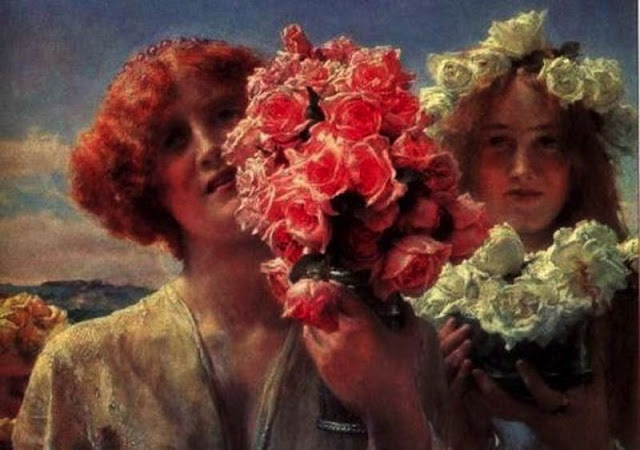 |
| Young Girls With Roses, 1911. Óleo sobre lienzo, 16 x 22 in. Museum of Art, Brigham Young University. |
Edad media
LA SERIE MEROVINGIA
 |
| La educación de los hijos de Clovis. The Education of the Children of Clovis, 1861. Oil on canvas. 127 x 176,8 cm. Private collection. |
Su primer gran éxito fue el cuadro La educación de los niños Clovis (1861), que exhibió en Amberes. Al año siguiente, recibió su primera medalla de oro en Ámsterdam. La educación de los niños Clovis (tres hijos jóvenes de Clovis y Clotilde lanzando hachas con su madre viuda presente enseñándoles cómo vengar a su padre) fue uno de los cuadros de la serie merovingia, de los que destacan Fredegonda de 1878 (expuesto en 1880), donde la desconsolada esposa o ama observa tras una cortina la boda de Chilperic I con Galeswintha. Es quizá en esta serie donde encontramos el más profundo espíritu romántico en su obra. Una de sus obras más apasionadas es Fredegonda en el lecho de muerte de Praetextatus, donde el obispo, apuñalado por orden de la reina, la maldice desde la cama en que muere.
 |
| Fredegonda en el lecho de muerte de Praetextatus. Fredegund visiting Pretextatius. Collection of Pushkin Museum, Moscow. |
El obispo, apuñalado por orden de la reina, la maldice desde la cama en que muere.
 |
| Fredegonda and Galswintha Ad 566, 1878. Oil on canvas. 139,8 x 129 cm. Bildenden Künste. Vienna. Austria. |
La desconsolada esposa o ama observa tras una cortina la boda de Chilperic I con Galeswintha.
 |
| Venantius Fortunatus Reading His Poems to Radegonda VI, 1862. Oil on canvas. 65 x 83,1 cm. Dordrechts Museum. Dordrecht. |
Venancio Fortunato leyendo sus poemas a Radegonda VI
EDAD MEDIA
 |
| Leaving Church in the Fifteenth Century, 1864. Oil on canvas. 57,1 x 39,4 cm. Private collection. |
Mitología
 |
| La muerte de Hipólito. The Death of Hippolytus. 1860. Oil on canvas. Private Collection. |
 |
| Pandora, 1881. Watercolour. 34,7 x 17,3 cm. Cecil Higgins Art Gallery. Bedford. |
 |
| Bacchante. 1907. Oil on wood. 41,5 x 33,5 cm. Private collection. |
 |
| Orante, 1907. Oil on wood. 41,5 x 33,5 cm. Private collection. |
 |
| The Golden Hour, 1908. Oil on canvas. 35,5 x 35,5 cm. Private collection. |
Civilizaciones antiguas
ANTIGUO EGIPTO
Otra de sus series reproduce la vida del antiguo Egipto. Una de las primeras obras de esta son Egipcios hace 3000 años de 1863 y La muerte del primogénito, de 1873. En esta serie están también: Egipcio en la entrada (1865), La momia (1867), El chambelán de Sesostris (1869), Viuda (1873) y José, supervisor del granero del faraón (1874). Trabajó mucho estas escenas de la vida pícara y macabra de Egipto, pero mucho más en sus representaciones de Grecia y Roma. Entre las que destacan Tarquinius Superbus (1867), Fidias y los mármoles de Elgin (1868), La danza pírrica (1868) y La vinería (1869).
 |
| The Finding of Moses, 1904. Óleo sobre lienzo, 137.5 x 213.4 cm. Colección Privada. |
 |
| José, supervisor del granero del faraón. Joseph, Overseer of Pharaoh´s Granaries, 1874. Oil on canvas. 33 x 43,1 cm. Private collection. |
 |
| La muerte del primogénito. Death of the Pharaoh's firstborn son, 1872. Oil on canvas. 77 × 124.5 cm (30.3 × 49 in). Rijksmuseum, Amsterdam. |
 |
| La viuda egipcia. Egyptian Widow, 1872. Oil on wood, 73,9 x 98,1 cm. Rijksmuseum, Amsterdam. |
 |
| Egytian Chess Players, 1865. Oil on wood. 39,8 x 55,8 cm. Private collection. |
 |
| Pastimes in Anciaent Egypt, 1863. Oil on canvas. 99,1 x 135,8 cm. Harris Museum and Art Gallery. Preston. England. |
 |
| Cleopatra at the Temple of Isis at Philae, 1912. Oil on canvas. 150,2 x 106,7 cm. Victoria and Albert Musseum. London. England. |
GRECIA CLÁSICA.
 |
| Women of Amphiss, 1887. Óleo sobre lienzo. Sterling and Francine Clark Institute. Williamstown. Mass. |
 |
| Dedication to Bacchus, 1889. Oil on canvas, 77.5 x 177.5 cm. Kunsthalle Hamburg. |
 |
| The Vintage Festival, 1870. Oil on canvas, 77 x 177 cm. Kunsthalle Hamburg. |
 |
| Greek woman. 1869. Oil on canvas, 66.7 x 47.09 cm. Private Collection. |
ROMA IMPERIAL
En 1869, envió de Bruselas a la Royal Academy Un Amateur romain y Une Danse pyrrhique, y más tarde otros tres cuadros, entre ellos Un Jongleur en 1870 cuando arribó a Londres. En ese momento, contaba con varias distinciones belgas y holandesas, medallas del Salón de París de 1864 y de la Exposición Universal de 1867. Su éxito continuó en Inglaterra, pintó en este período cuadros como The Vintage Festival (1870), The Picture Galleryy The Sculpture Gallery (1875), An Audience at Agrippa's (1876), The Seasons (1877), Sappho (1881), The Way to the Temple (1883), trabajo galardonado, Hadrian in Britain (1884), The Apodyterium (1886), o The Woman of Amphissa (1887). Uno de sus cuadros más importantes fue The Roses of Heliogabalus (Las rosas de Heliogábalo) (1888) basado en la vida del depravado emperador romano Heliogábalo An Earthly Paradise ( Paraíso terrenal) (1891), y [Spring]] (Primavera) (1894). Muchos de ellos eran exquitos cuadritos como Gold-fish de 1900.
 |
| Tarquinius Superbus, 1867. Oil on panel. Private Collection. |
 |
| An Audience at Agrippa's, 1876. Oil on wood. 90,8 x 62,8 cm. Dick Institute. Kilmarnock. |
 |
| After the Audience, 1879. Oil on wood. 91,4 x 66 cm. Private collection. |
 |
| Interior of Caius Martius' House, 1907. |
 |
| Bacanal. Bacchanal, 1871. |
| Antony and Cleopatra, 1885. Óleo sobre tabla, 65.5 x 92 cm. Colección Privada. |
 |
| Lesbia and sparrow, 1866. |
 |
| Agrippina with the ashes of Germanicus. |
 |
| Ave, Caesar! Io, Saturnalia!, 1880. Oil on panel. Akron Art Museum, USA. |
 |
| A Roman Emperor AD 41, 1871. Representa al futuro emperador, Claudio, escondiendose tras una cortina tras el asesinato del emperador Calígula. En el suelo yace asesinada la esposa de Calígula. |
 |
| Proclaiming Claudius Emperor, 1867. |
 |
| The Triumph of Titus, 1885. Oil on wood. 44,3 x 29,1 cm. Walter Art Gallery. Baltimore. USA. |
 |
| Hadrian Visiting a Romano-Britis Pottery, 1884. Oil on canvas (cut and repainted). 159 x 171 cm. Stedelijk Museum. Amsterdam. Holanda. |
 |
| Caracalla and Geta, 1907. Óleo sobre tabla. 123 x 154 cm. Colección Privada. |
 |
| Caracalla, 1902. Oil on wood. 23,5 x 39,5 cm. Private collection. |
 |
| Las rosas de Heliogábalo, 1888. Óleo en lienzo. México, colección particular |
DESNUDOS
 |
| Strigils and Sponges, 1879. Watercolor, 31.8 x 14 cm. Private Collection. |
 |
| The Tepidarium, 1881. Oil on wood. 24,2 x 33 cm. Lady Lever Art Gallery. Port Sunlight. Liverpool. England. |
 |
| The Frigidarium, 1890. Oil on canvas, 45.1 x 59.7 cm. Private Collection. |
 |
| A Favourite Custom, 1909. Óleo sobre tabla. 66,1 x 45 cm. Tate Gallery. Londres. Inglaterra. |
 |
| Thermae Antoninianae, 1899. Óleo sobre lienzo, 152.5 x 95 cm. Colección Privada. |
 |
| A Sculptors Model, 1877. Oil on canvas. 195 x 86 cm. Private collection. |
 |
| Roman studio, 1877. Museo Nacional de Bellas Artes, La Habana, Cuba. |
 |
| Exhausted Maenides. 1873-74. Oil on canvas. 59,1 x 132 cm. Van Gogh Museum. Amsterdam. Holanda. |
 |
| A Bath (An Antique Custom). |
ESCENAS DE ÉPOCA
 |
| The Proposal. |
 |
| Ask Me No More, 1906. Óleo sobre lienzo. 80,1 x 115,7 cm. Colección Privada. |
 |
| A kiss, 1891. Óleo sobre tabla. 45.7 x 62.7 cm. Private Collection. |
 |
| Spring, 1894. Oil on canvas. 179,2 x 80,3 cm. J. Paul Getty Museum. Malibu. |
 |
| Spring in the Gardens of the Villa Borghese, 1877. Acuarela. Colección Privada. |
 |
| Between Venus and Bacchus. |
 |
| Silver Favourites, 1903. Oil on wood. 69,1 x 42,2 cm. Manchester City Art Galleries. England. |
 |
| A coign of vantage, 1895. Oil on wood, 64 x 44,5 cm. J. Paul Getty Museum, Malibu. |
 |
| Votive, 1873. (Offerta votiva) Acquerello, 47.3 x 39.4 cm. Collezione privata . |
| The Colisseum, 1896. Oil on wood. 112 x 73,6 cm. Private collection. |
 |
| A Crown. |
 |
| The Oleander, 1882. Oil on canvas. 101,5 x 53,5 cm. Royal Academy of Arts. London. Engalnd. |
 |
| Confidences. |
 |
| Not at Home, 1879. Oil on panel. Walters Art Museum (United States). |
 |
| Between Hope and Fear, 1876. Oil on canvas. 78,1 x 128,2 cm. Private collection. |
 |
| A Street Altar, 1883. Watercolour. 34,7 x 17,3 cm. Cecil Higgins Art Gallery. Bedford. |
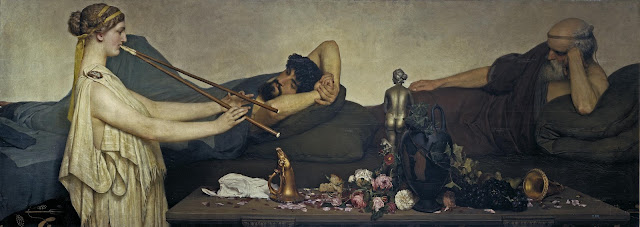 |
| Pompeian scene or The siesta, 1868. Escena pompeyana o La siesta. Óleo sobre lienzo. Museo del Prado, Madrid, España. |
 |
| A Pyhhric Dance, 1869. Oil on wood. 40,6 x 81,3 cm. Guildhall Art Gallery. London. England. |
 |
| Under the Roof of Blue Ionian Weather, 1898-1901. |
 |
| Favourite Poete, 1888. Óleo sobre tabla. Lady Lever Art Gallery. |
 |
| Rivales inconscientes, 1893. Óleo sobre lienzo. Museo y Galería de Arte de la Ciudad de Bristol. Bristol. Inglaterra. |
 |
| A Balneator, 1877. Watercolour, 36,5 x 26,5 cm. Private collection. |
 |
| An Oleander. 1882. 1882. Oil on wood. 92,8 x 64,7 cm. Private collection. |
 |
| An Exedra. 1869. Oil on wood. 38 x 59,8 cm. Frances Lehman Loeb Art Center. |
 |
| In a Rose Garden. 1889. Oil on canvas. 37,5 x 49,5 cm. Private collection. |
 |
| Love´s Votaries, 1891. Oil on canvas. 87,6 x 165,7 cm. Laing Art Gallery. Newcastle-upon-Tyne. England. |
 |
| Pleading, 1876. Oil on canvas. 21,5 x 33,5 cm. Guildhall Art Gallery. London. England. |
 |
| When Flowers Return, 1911. Oil on wood. 35,5 x 52,1 cm. Private collection. |
 |
| A Difference of Opinion, 1896. Óleo sobre tabla. 38,1 x 22,3 cm. Colección Privada. |
 |
| A Juggler, 1870. Oil on canvas, mounted on wood. 78,7 x 49,5 cm. Private collection. |
 |
| A Reading From Homer, 1885. Óleo sobre lienzo. 91 x 183 cm. Colección de George W. Elkins. Museo de Arte de Filadelfia. Filadelfia. USA. |
 |
| A Romano-British Potter, 1884. Oil on canvas (cut and repainted). 152,2 x 80 cm. Musée d´Orsay. París. France. |
 |
| An Apodyterium, 1886. Oil on wood. 44,5 x 59,5 cm. Private collection. |
 |
| Entrance to a Roman Theatre, 1866. Oil on canvas. 70,4 x 98,4 cm. Private collection. |
 |
| Expectations, 1885. Óleo sobre tabla. Colección Privada. |
 | |
|
 |
| Gallo-Roman Women, 1865. Oil on canvas. 80,6 x 101,6 cm. Private collection. |
 |
| Her Eyes are with Her Thoughts, 1897. Colección Privada. |
 |
| Love´s Jewelled Fetter, 1895. Oil on canvas. 63,5 x 46,1 cm. Private collection. |
 |
| Preparations in the Coliseum, 1912. Oil on canvas. 154 x 80 cm. Private collection. |
 |
| Promise of Spring, 1890. Óleo sobre tabla. Museo de Bellas Artes de Boston. Massachussetts. USA. |
 |
| Resting, 1882. Oil on wood. 23,5 x 16,6 cm. Private collection. |
 |
| The Flower Market, 1868. Oil on wood. 42,12 x 58 cm. Manchester City Art Galleries. England. |
 |
| The Poet Gallus Dreaming, 1892. Oil on wood. 23,5 x 16,3 cm. Private collection. |
 |
| The Wine Shop, 1869-1874. Óleo sobre tabla. Picture type Pre-Raphaelite related. |
 |
| The Year is at the Spring, 1902. |
 |
| Unwelcome Confidence, 1895. Oil on wood. 47,5 x 28,5 cm. Private collection. |
 |
| Vain Courtship, 1900. Óleo sobre lienzo. Colección Privada. |
 |
| Welcome Footsteps, 1883. Oil on wood. 41,9 x 54,8 cm. Private collection. |
 |
| Whispering Noom, 1896. Oil on canvas. 56 x 39,3 cm. Private collection. |
 |
| Xanthe and Phaon, 1883. Watercolour. 45,1 x 32,4 cm. Walters Art Gallery. Baltimore. USA. |
| A Roman Family. 1868. Oil on panel. Private Collection, UK. |
| Balneatix. 1876. Watercolour on paper. Setton Collection, Paris, France. |
| At Aphrodite's Cradle. 1908. Oil on canvas. Dr. & Mrs. Irving-Warner, California, USA. |
LAS ARTES
 |
| The Collector of Pictures in the Time of Augustus, 1867. Oil on wood. 71 x 46,4 cm. Private collection. |
 |
| Variation. |
 |
| The Picture Gallery, 1874. Oil on canvas. 219,7 x 166 cm. Towneley Hall Art Gallery and Museum. Burnley. |
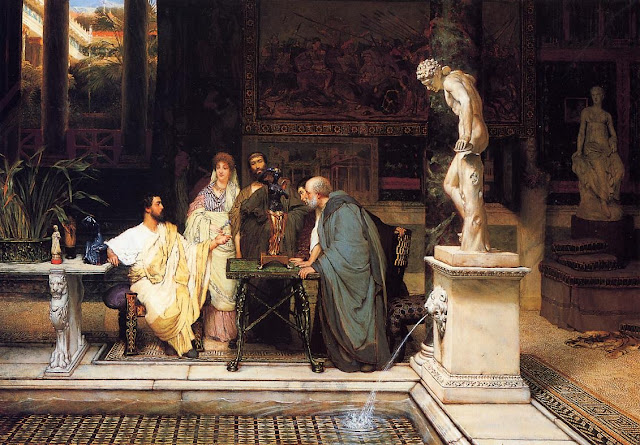 |
| A Roman Art Lover, 1868. Oil on wood. 53,3 x 80 cm. Yale University Art Gallery. New Haven. USA. |
 |
| A Roman Art Lover, 1870. Oil on wood. 73,5 x 101,6 cm. Milwaukee Art Museum. Layton Art Collection. USA. |
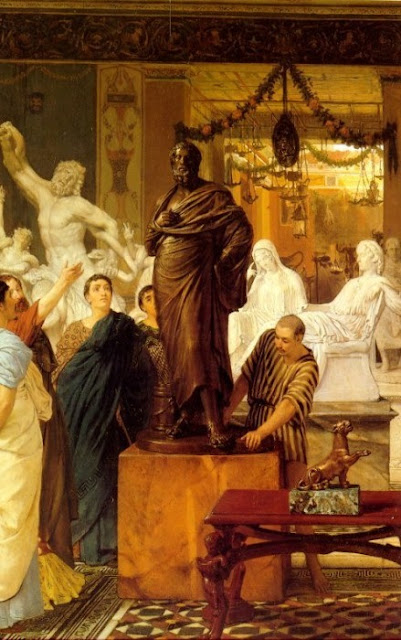 |
| A Sculpture Gallery in Rome at the Time of Agrippa, 1867. Oil on wood. 62,2 x 46,9 cm. Montreal Museum of Fine Arts. |
 |
| The Sculpture Gallery. by Auguste Blanchard (1819-1898) after Lawrence Alma-Tadema (1836-1912). |
 |
| The Sculpture Gallery, 1874. Oil on canvas. 223,4 x 171,5 cm. Hood Museum of Art. Dartmouth College. Hanover. Germany. |
 |
| Sculptors in Ancient Rome, 1877. Oil on copper. |
 |
| Architecture in Ancient Rome, 1877. Private Collection. |
 |
| Sappho and Alcaeus, 1881. Óleo sobre lienzo. Galería de Arte Walters de Baltimore. Maryland. USA. |
 |
| Tibullus at Delia's, 1866. Oil on wood. 43,9 x 66 cm. Museum of FIne Arts. Boston. USA. |
 |
| Catullus at Lesbia, 1865. Oil on canvas. 39,5 x 54,5 cm. Private collection. |
 |
| Catullus Reading his Poemas at Lesbia´s House, 1870. Oil on canvas. 39,3 x 48,2 cm. Private collection. |
Literatura
 |
| Faust and Marguerite. 1857. |
 |
| Queen Katherine of France (play "Henry V"), 1888. |
Interiores
 |
| San Clemente, 1863. Oil on canvas. 63,5 x 51 cm. Fries Museum. Leeuwarden. |
 |
| The Drawing Room at Townshend House. Watercolour. 26 x 17,5 cm. Royal Academy of Arts. London. England. |
Paisajes
 |
| Antium seen from outside the City Walls: Desing for Coriolanus, 1880. Watercolour. 38,9 x 51,6 cm. Private collection. |
 |
| Degrees in the Shade, 1876. Oil on canvas (mounted on wood). 35,5 x 21,6 cm. Fitzwilliam Museum. Cambridge. England. |
 |
| Sunny Days, 1874. Oil on canvas. 21,5 x 34,2 cm. Yale University Art Galery. New Haven. USA. |
Costumbres
 |
| A Hearty Welcome, 1878. Óleo sobre lienzo. 30 x 93 cm. Museo Ashmolean de Oxford. Oxford. Inglaterra. |
 |
| A World of their Own. |
 |
| An Earthly Paradise, 1891. Oil on canvas. 86,5 x 165 cm. Private collection. |
 |
| Sunday Morning, 1871. Óleo sobre tabla. |
Otras obras
 |
| Crossing of the River Berizina, 1859-69. Oil on canvas. 39 x 73 cm. Historisch Museum. Amsterdam. Holanda. |
 |
| Simeon Solmon, 1865. Oil on canvas. 112 x 101,5 cm. Private collection. |
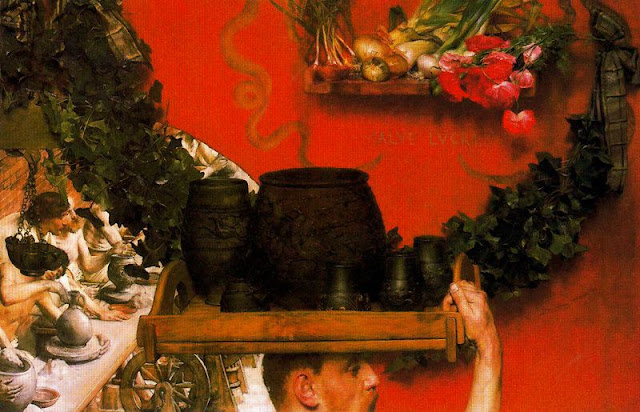 |
| The Roman Potters in Britain, 1884. Oil on canvas (cut and Repainted). 76,2 x 119 cm. Royal Collection. The Hague. |
| In My Studio. 1893. Oil on canvas. Location unknown. |
| A Family Group. 1896. Oil on panel. Royal Academy, London, UK. |
| "Nobody Asked You, Sir!" She Said. 1896. Watercolour on paper. Art Gallery of South Australia, Adelaide, Australia. |
| A Flag of Truce. 1900. Oil on panel. Mr. & Mrs. Harold H. Stream, New Orleans, USA. |
| Summer Offering. 1911. Oil on panel. Dr. George Nicholson, Oregon, USA. |
Fuentes
- Wikipedia
- Wikipedia commons
- Wikipedia inglesa
- La ciudad de la pintura
- ForoXerbar
- Olga's Gallery
- Ŧhe ₵oincidental Ðandy
- Obras de Internet
ANEXO
Retratos
 |
Portrait of Anna Alma-Tadema, 1883
(Younger daughter of Sir Lawrence by his first wife)
|
 |
| Portrait of Mrs. Charles Wyllie. |
 |
| Miss Alice Lewis, 1884. |
 |
| Master John Parsons Millet, 1889. |
 |
| Mrs. George Lewis and her daughter, Elizabeth, 1899. |
 |
| Gathering Pansies. |
Escenas de época
 |
| Who Is It?, 1884. |
 |
| The Voice of Spring, 1910. |
 |
| Prose, 1879. |
 |
| Poetry, 1879. |
 |
| The Discourse. |
 |
| The Year's At The Spring, 1902. |
 |
| The Soldier of Marathon. |
 |
| Among The Ruins, 1902-1904. |
 |
| Promise of Spring, 1890. |
 |
| Godspeed!, 1893. |
 |
| A Silent Greeting, 1889. |
 |
| The Conversion of Paula by Saint Jerome, 1898. |
 |
| The Wat To The Temple, 1882. |
 |
| Thou Rose of All The Roses, 1883. |
 |
| Water Pets. |
 |
| Love's Jewelled Fetter, 1895. |
 |
| The Honeymoon, 1868. |
 |
| From An Absent One, 1871. |
 |
| In The Temple, 1871. |
 |
| A Female Figure Resting (or Dolce far Niente). |
 |
| Courtship |
 |
| A Roman Scribe Writing Dispatches. |
 |
| Spring Flowers. |
 |
| Portrait of a Woman. |
 |
| The Parting Kiss. |
 |
| Pottery Painting. |
 |
| The Epps Family Screen. |
 |
| Boating. |
 |
| In the Peristyle |
 |
| A Birth Chamber Seventeenth Century. |




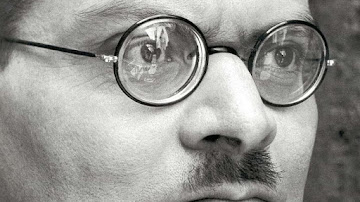
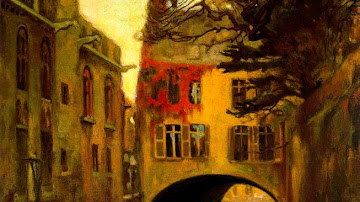

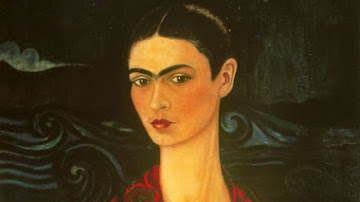
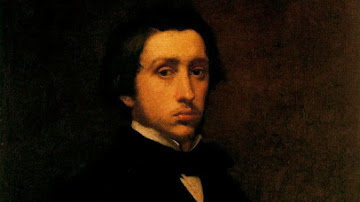
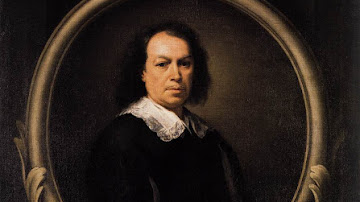


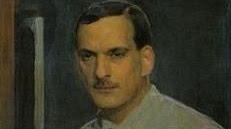

Saludos.
Bueno, nada más que me ha salido un comentario muy largo! ¡uf! Solo añadir que me ha gustado mucho tu poema sobre las fresas y que suscribo todo lo que dices en tu articulo sobre los recortes a la educación.
Saludos, Eduardo.
Un abrazo grandoteee!
Un beso... o besoteee!!